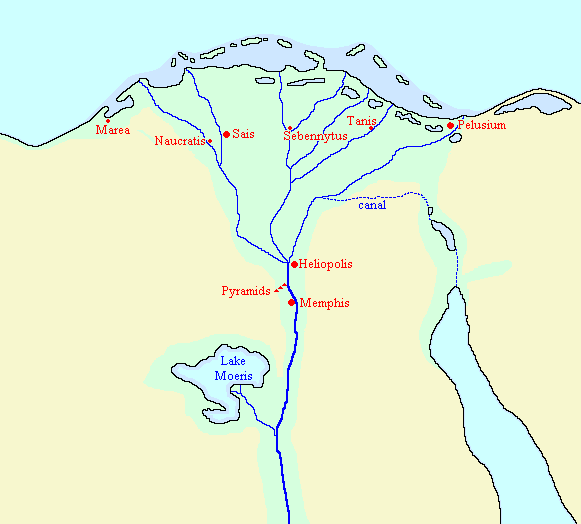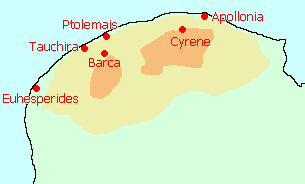Aryandes
Aryandes: Persian nobleman, after 525 first satrap of Egypt. He died after 512.

In 526 BCE, pharaoh Amasis of Egypt died. He was succeeded by his son Psammetichus III, who was faced with a crisis that had been long in the making: the Persians threatened to invade his kingdom. In fact, Amasis may have provoked the aggression himself by allying himself to the Lydian king Croesus, who had attacked the Persian empire in c.547, believing that he could overthrow a great empire. His own. The new master of Lydia was the Persian king Cyrus the Great, who was not the man to forgive an insult. Eight years later, he overthrew the Babylonian Empire and laid a garrison in Gaza, dangerously close to the Egyptian frontier. When Cyrus' son Cambyses succeeded him in 530, he inherited the war against Egypt; and Psammetichus inherited the war of his father.
It did not last very long. The Persian preparations had been very careful, the Egyptian navy refused to fight, and after one single battle near Pelusium, the Persians had created a bridgehead in the eastern delta. The fall of Memphis was a matter of time, and the pharaoh was taken captive. When he later attempted a rebellion, he was executed.

Cambyses stayed in Egypt until 522, trying to conquer Kush (modern Sudan). This campaign was unsuccessful, but Cambyses was able to receive tokens of submission ("earth and water") from the Greek king Arcesilas III of Cyrene. The Persian king may have wanted to stay in Egypt, but in the late spring he heard that his brother Smerdis had revolted. Cambyses hurried back to Asia.
When he left the ancient country of the Nile, he left behind a Persian nobleman named Aryandes as governor, or "satrap", the use his title. It was his task to collect taxes (twenty tons of silver every year), protect the Persian empire (the word "satrap", khšaçapavan, means "protector of the realm"), and administer justice. To secure peace, Aryandes could use the Persian garrison, which was stationed on several places, such as the old capital of Egypt, Memphis, Pelusium, and Elephantine in the far south. It is interesting to note that the last-mentioned garrison consisted of Jewish soldiers.
Aryandes was faced with a problem: a man named Petubastis revolted, probably in October or November 522. This would have been a serious matter in any case, but as it turned out, it was even worse. He could not count on support from the Persian army, which would have been normal. The cause of the rebellion is not known, but it may be noted that the Greek military author Polyaenus offers a confused account of a rebellion against Aryandes, caused by the severity of his taxation.
Cambyses died, probably of natural causes, in Syria, leaving the Persian army without leader. At the same time, it became clear that the rebel king was not Cambyses' brother but an usurper named Gaumâta. The kings' lance carrier -this was a very important court official- Darius was elected as general and marched to Media, where he and six companions killed the usurper (29 September 522). Now Darius was king, and he may have wanted to send reinforcements to Aryandes, but he was faced with a civil war against the Persian nobleman Vahyazdâta, and rebellions in Babylonia and Media. They lasted until December 521.
We don't know how Aryandes coped with the Egyptian crisis, but he managed to restore order. Although the rebels of Egypt are mentioned in the Behistun inscription, our main source for the years 522-520, we do not read about reinforcements being send to Aryandes. Yet, the situation had been serious enough for king Darius to visit Egypt as soon as he was able to. In September 518, he arrived.
Aryandes had had four-and-a-half years to get acquainted with the ancient country of the Nile, and he had learned how he could gain support for Persian rule. It happened that a few weeks before Darius arrived in Egypt, the Apis bull, a manifestation of the Memphite creation god Ptah, had died. During his visit, the great king buried the animal and ordered the search for a new Apis, which was found on 9 November. No doubt, Aryandes had told the king how to behave towards the strange, bull-shaped deity. He must also have been the man who advised Darius to give precious gifts to the temple of Neith of Sais and the sanctuary of Osiris at Busiris. At Hibis in the Kharga oasis, in the western desert, the great king dedicated a temple to Amun (although it is likely that pharaoh Psammetichus II [595-589] had already started its construction).
Another royal order was that Aryandes (who no doubt had advised the king to give this order) had to invite the wise men of Egypt to collect the old pharaonic laws. Although the Achaemenid authorities were usually tolerant towards subject nations, this measure is unparalleled. It seems that Aryandes really respected the Egyptian civilization.

He continued the foreign policy of the last pharaohs, who had tried to conquer the Cyrenaica in the west. The Persian satrap was more successful than the Egyptian kings. When king Arcesilas of Cyrene was expelled and murdered (c.512), his mother Pheretima invited the Persians. This was the pretext Aryandes needed. He accepted the invitation and sent an army. It was commanded by a Persian named Badres and an Egyptian named Amasis, perhaps a son of Psammetichus III (although the Greek researcher Herodotus of Halicarnassus believes he was a Persian). They captured the town Barca, probably because Pheretima and her grandson Battus could ensure the tribute from Cyrene - so there was no need to take this town.
Darius and Aryandes also dug a canal between the river Nile and the Red Sea. The idea was not original: again, the Persians pursued the policy of the pharaohs. Necho II had already contemplated the construction of this watercourse. It was finished in 497.
Perhaps, Aryandes was, by then, already dead. His ultimate fate is described by Herodotus:
Darius had issued a gold coinage, of which the metal was of the greatest possible purity, and Aryandes as governor of Egypt had followed suit by a similar issue of silver - and indeed to this day the purest silver coinage is the aryandic. Darius, when he came to know of this, disguised the real cause of his anger by bringing a charge of rebellion against Aryandes, and had him executed.note
This story poses several problems. Firstly, no numismatist has ever identified these coins. In the second place, it is hard to believe that the purity of Aryandes' silver coinage was the real cause of Darius' anger. In the third place, removal of an Egyptian satrap was almost impossible, because no army could easily cross the Sinai desert.
It is possible, however, to read through the story, although we must sacrifice the story about the coins, which is of dubious value anyhow. But in 499 the Ionian Greeks had revolted and the Persians desperately needed a navy. The Greeks had already occupied part of Cyprus, and the loyalty of the Phoenician towns was dubious: if Cyprus fell, they were the first to be under attack, and several Phoenician towns on Cyprus wavered. A loyal navy was needed, and Egypt offered one.
However, Aryandes, who had been satrap for a quarter of a century, was a liability. He sympathized too much with the Egyptians. Darius distrusted the satrap, and had to replace him. He hid the real motive - in his tomb inscription, he boasted that he was not hot-tempered - went to Egypt as if to open the new canal, and when he had safely arrived with the royal bodyguard (in 497), he ordered Aryandes to be arrested and executed. Admittedly, this reconstruction is very speculative and leaves questions, but it is not impossible. We will never know the truth, unless new documents will be discovered - and in Egypt, Babylonia and Persia, this is by no means impossible.
By 492, the satrap of Egypt was a man named Pharandates.